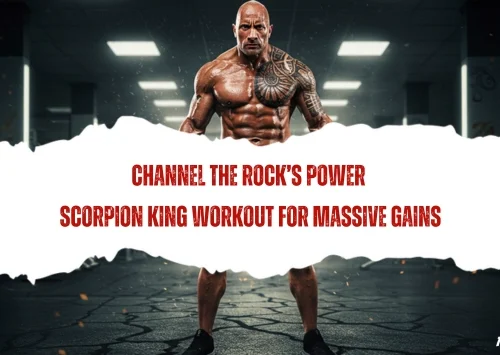
Featured Snippet Summary
Wondering about morning vs evening workouts for achieving your fitness goals? While consistency is king, timing can play a role. Mornings may offer benefits for habit formation and potentially enhanced fat burning for some, leveraging hormonal advantages. Evenings often align with peak physical performance, potentially leading to better strength gains and muscle growth. Ultimately, the best time depends on your personal chronotype, schedule, and adherence. Key considerations include:
- Morning: Potentially better consistency, hormonal edge for fat loss, less scheduling conflicts.
- Evening: Peak strength & performance, stress relief after work, potentially better for muscle hypertrophy.
- Key Factor: Choose the time you can stick with consistently for long-term results.
Table of Contents
Morning vs Evening Workouts: The Ultimate Guide to Timing Your Training for Fat Loss and Muscle Gain
➲ The Great Debate: Sunrise Sweat or Sunset Grind?
Ever scrolled through Instagram and seen ultra-motivated fitness buffs crushing workouts while the rest of us are hitting snooze? Or maybe you’ve seen packed gyms buzzing with energy long after the workday ends? It sparks the age-old question for anyone serious about getting results: When it comes to morning vs evening workouts, which timing reigns supreme for shedding fat and building lean muscle?
Forget the fitness myths that declare one time definitively “better” than the other. The truth, as with most things in health and fitness, is far more nuanced. As a certified personal trainer who has worked with hundreds of clients navigating busy schedules and diverse body clocks, I can tell you this: the absolute best time to work out is the time you can consistently do it.
However, that doesn’t mean timing is irrelevant. Your body does operate on internal clocks (hello, circadian rhythms!), and hormones fluctuate throughout the day. Understanding these patterns and the pros and cons of hitting the gym at dawn versus dusk can help you optimize your efforts and potentially accelerate your results. Let’s dive deep into the morning vs evening workouts discussion, backed by science and real-world coaching experience, to help you find your perfect training window.

Gearing Up for Success: Your Workout Essentials (Anytime!)
Before we dissect the timing, let’s ensure you’re set up for success regardless of when you train. Consistency crumbles without preparation. Here’s what you need:
- ➲ The Right Gear:
- Appropriate Attire: Comfortable, breathable clothing that allows full range of motion. Don’t underestimate the power of feeling good in your workout clothes!
- Supportive Footwear: Crucial for preventing injuries, especially for cardio or high-impact activities. Ensure your shoes match your chosen activity (running shoes for running, cross-trainers for mixed workouts).
- (Optional) Basic Equipment: If working out at home, consider investing in versatile basics:
- Resistance Bands: Fantastic for warm-ups, activation, and adding challenge without heavy weights.
- Dumbbells or Kettlebells: Adjustable ones are great for saving space. Start with a weight that feels challenging but allows good form for 8-12 reps.
- Yoga Mat: For floor exercises, stretching, and comfort.
- Home Substitutions: No weights? No problem! Use water bottles, canned goods, backpacks filled with books, or focus on challenging bodyweight exercises (we’ll cover modifications later!).
- ➲ The Winning Mindset:
- Clear Goals: Why are you working out? For fat loss? Muscle gain? Stress relief? Keep your ‘why’ front and center. It’s your fuel on low-motivation days.
- Positive Self-Talk: Banish the “I can’t” thoughts. Replace them with “I’ll try,” “I’m getting stronger,” or “Every rep counts.” Your mind is your most powerful muscle.
- Patience & Persistence: Results take time. Celebrate small wins (like showing up!) and trust the process. This isn’t a sprint; it’s a marathon (or maybe a series of well-paced intervals!).
- ➲ Hydration Station:
- Water Bottle: Non-negotiable. Keep it filled and sip throughout the day, especially before, during, and after your workout. Aim for pale yellow urine as a general hydration indicator.
- (Optional) Electrolytes: For intense or long sessions (over 60-90 mins), especially in hot weather, consider an electrolyte drink to replenish lost minerals.
- ➲ Your Workout Space:
- Dedicated Area (Even Small): Whether it’s a corner of your living room, garage, or a membership at a local gym, having a designated space helps mentally shift you into “workout mode.”
- Safety First: Ensure enough clear space to move freely without bumping into furniture or hazards. Good lighting and ventilation are also important.
Pro Tip: Prepare everything the night before! Lay out your clothes, pack your gym bag, fill your water bottle. This removes decision fatigue and makes getting started much easier, especially for those early morning workouts.

Clocking In: Time Commitment & Weaving Workouts into Your Week
One major hurdle isn’t when to work out, but feeling like you don’t have enough time. Let’s break that barrier.
- ➲ How Long Should a Session Be?
- Quality over Quantity: An effective workout doesn’t need to last hours. Aim for 30-60 minutes of focused effort most days.
- Fat Loss Focus: Incorporate a mix of strength training (30-45 mins) to build calorie-burning muscle and cardiovascular exercise (20-30 mins, steady-state or HIIT).
- Muscle Gain Focus: Prioritize strength training (45-60 mins), focusing on progressive overload (gradually increasing weight, reps, or sets). Add cardio as needed for overall health, but don’t let it compromise recovery for muscle growth.
- Minimum Effective Dose: Even 15-20 minutes of intense activity (like a HIIT session or a quick circuit) is far better than nothing!
- ➲ Crafting a Realistic Weekly Schedule:
- Start Steady: If you’re new or returning to exercise, aim for 3 days a week, spread out (e.g., Monday, Wednesday, Friday).
- Build Up: As you get fitter and more consistent, progress to 4-5 days a week.
- Listen to Your Body: Include rest days! Muscle repair and growth happen during recovery. Overtraining can lead to injury, burnout, and hinder progress.
- Flexibility is Key: Life happens. If you miss a planned workout, don’t scrap the whole week. Adjust, fit in a shorter session later, or simply get back on track the next day.
- ➲ Finding the Time – Real Talk:
- Think about it: A 45-minute workout is shorter than most Netflix episodes, less time than endlessly scrolling social media, and about the time it takes for a typical lunch break.
- Time Audit: Track your day for a few days. Where does your time really go? You might be surprised where you can carve out 30-60 minutes. Could you wake up 30 minutes earlier? Use your lunch break? Cut down on screen time in the evening?
- Anchor Your Habit: Link your workout to an existing part of your routine (e.g., right after waking up, immediately after work, before dinner).
Whether you choose morning vs evening workouts, the commitment needs to be realistic and sustainable for your lifestyle.
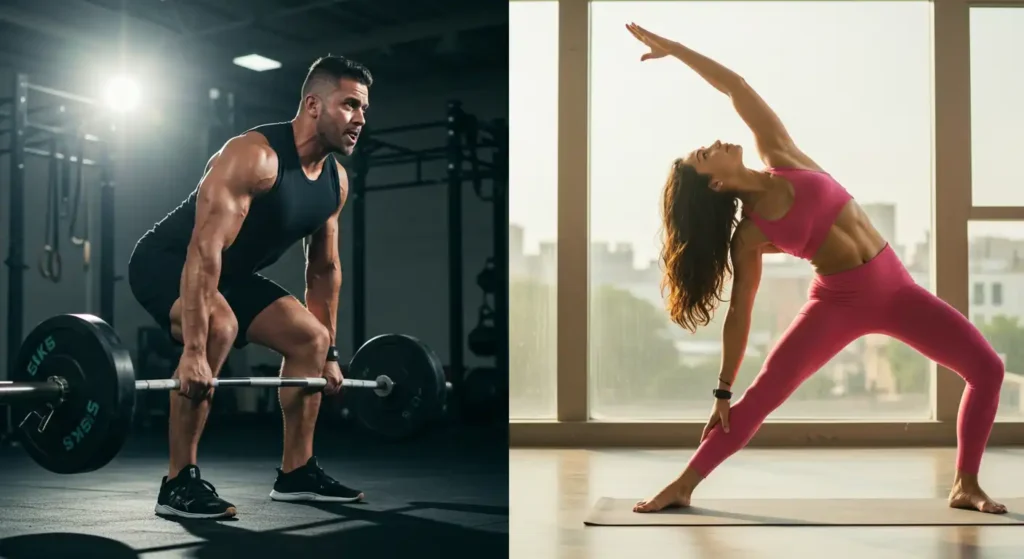
Morning vs. Evening Workouts: Tailoring Your Routine Structure
Okay, let’s get into the nitty-gritty. While a specific routine isn’t the focus here (as that depends on individual goals), how you structure your workout might differ based on timing.
The Early Bird Approach: Capitalizing on Morning Energy
- ➲ Potential Perks: Many people feel mentally fresh and focused in the morning. Fewer scheduling conflicts tend to pop up. Hormonally, cortisol (the stress/alertness hormone) is naturally higher, which might aid in mobilizing fat stores for energy. Some studies suggest fasted cardio (working out before breakfast) might lead to slightly more fat being burned during the session, though its overall impact on 24-hour fat loss is debated and highly individual.
- ➲ Structuring Tips:
- Warm-up is CRUCIAL: Your body temperature is lower, and muscles/joints are stiffer. Spend extra time (5-10 mins) on dynamic stretching (arm circles, leg swings, torso twists) and light cardio to prepare.
- Consider Intensity: You might not hit peak strength first thing. Listen to your body. Some prefer moderate intensity cardio or focused strength sessions. Others find HIIT circuits energizing.
- Fueling Strategy: Decide if you’ll train fasted or have a small, easily digestible carb/protein snack 30-60 mins before (e.g., banana, small protein shake). Experiment to see what feels best for energy levels without causing digestive upset.
- Mental Barrier: The biggest challenge? Getting out of bed! Setting multiple alarms, putting your alarm across the room, and having your gear ready can help.
- ➲ Example Morning Flow: 5-10 min Dynamic Warm-up -> 30 min Strength Circuit (Compound movements like squats, push-ups, rows) -> 15 min Steady Cardio (Brisk walk/jog) -> 5 min Cool-down & Stretch.
Important Note: Chronotype Matters!
- ➲ Are you naturally an early bird or a night owl? Your chronotype (your body’s natural inclination to sleep and wake at certain times) plays a HUGE role. Forcing yourself into a schedule that fights your biology often leads to burnout and inconsistency.
- ➲ Experiment: Try both morning and evening workouts for a week or two each. Pay attention to your energy levels, performance, mood, and sleep quality. Which feels more sustainable and enjoyable?
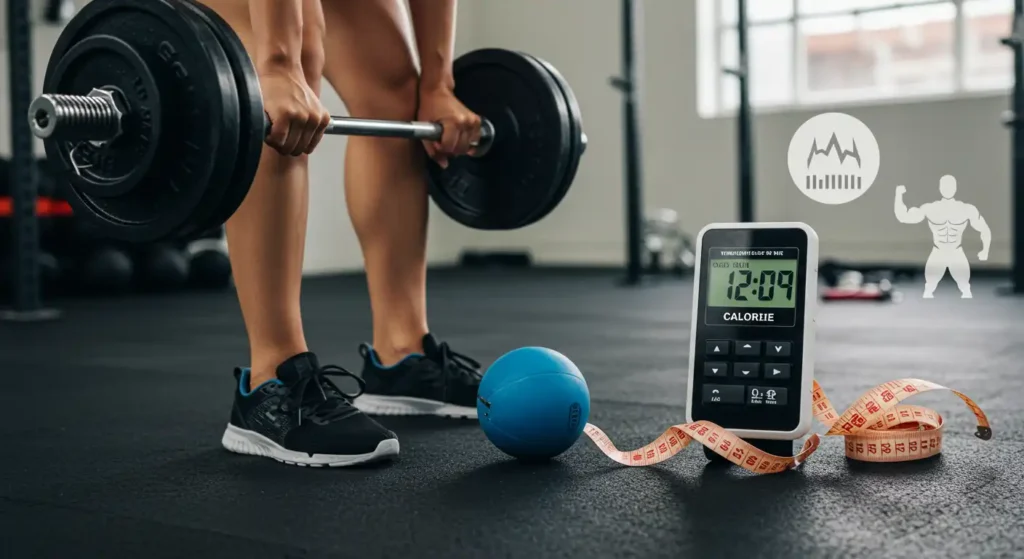
The Bottom Line Benefits: Calorie Burn, Fat Loss, and Muscle Gain Insights
Let’s address the core question: Does the morning vs evening workouts debate impact fat loss and muscle gain outcomes?
- ➲ Calorie Burn:
- The total calories burned depend primarily on the intensity, duration, and type of workout, along with your individual body weight and metabolism – not strictly the time of day. A hard 45-minute workout burns roughly the same calories whether done at 6 AM or 6 PM.
- EPOC (Excess Post-Exercise Oxygen Consumption) / “Afterburn”: Intense exercise, particularly HIIT and heavy strength training, creates an “afterburn” effect where your body continues to burn extra calories post-workout. While a morning workout might kickstart this earlier in the day, the overall magnitude depends on the workout’s intensity, not the clock.
- Consistency = Compounding Burn: The biggest factor for calorie expenditure over time is simply doing the workouts consistently.
- ➲ Fat Loss:
- Morning Advantage? Some research suggests morning exercise, especially fasted, might tap into fat stores more effectively during the session. Higher morning cortisol could also play a role in fat mobilization. Furthermore, exercising early often leads to better adherence and can set a positive tone for healthier choices throughout the day. Establishing the habit before daily chaos ensues is a major plus for many.
- Evening Potential: If you perform better and can push harder in the evening, you might achieve higher intensity, leading to greater overall calorie burn and potentially better long-term fat loss results indirectly.
- Verdict: While mornings might offer a slight physiological edge for fat burning mechanisms and habit formation for some, the difference isn’t likely to be dramatic. Consistency and overall calorie balance (calories in vs. calories out) remain the most critical factors for fat loss.
- ➲ Muscle Gain (Hypertrophy):
- Evening Advantage? Research consistently shows that metrics like muscle strength, power, and endurance tend to peak in the late afternoon/early evening. This aligns with higher core body temperature and potentially more favorable hormonal profiles (like the testosterone-to-cortisol ratio) for muscle building and performance later in the day. Training when you’re strongest allows you to lift heavier and provide a greater stimulus for growth.
- Morning Potential: You can absolutely build muscle training in the morning! Ensuring adequate warm-up and potentially consuming protein/carbs beforehand can help optimize performance. Consistency is still paramount.
- Verdict: For pure performance and potentially optimizing hypertrophy signals, evenings might hold a slight edge due to physiological peaks. However, significant muscle growth is achievable with consistent, progressive morning training too. Read our complete guide to Muscle Hypertrophy here.
| Feature | Morning Workouts | Evening Workouts | Key Takeaway |
|---|---|---|---|
| Consistency | Easier to establish habit before day gets busy. | May be harder if daily fatigue/stress interferes. | Choose what you’ll STICK to. |
| Performance | May be lower initially (stiffness, lower temp). | Often peak strength, power, endurance. | Evening may have slight edge. |
| Fat Burning | Potential hormonal edge, fasted cardio option. | Higher intensity potential can increase overall burn. | Minor difference, consistency wins. |
| Muscle Gain | Achievable with consistency & proper fueling. | Peak performance may allow greater growth stimulus. | Evening might be optimal. |
| Hormones | Higher cortisol (alertness, fat mobilization). | Potentially better Testosterone/Cortisol ratio later. | Complex, varies individually. |
| Sleep | Generally positive impact on sleep cycle. | Intense late sessions can disrupt sleep for some. | Finish >90 mins before bed. |
| Practicality | Fewer schedule conflicts? Quieter gyms? | Stress relief after work. Gyms might be busier. | Depends on personal life. |
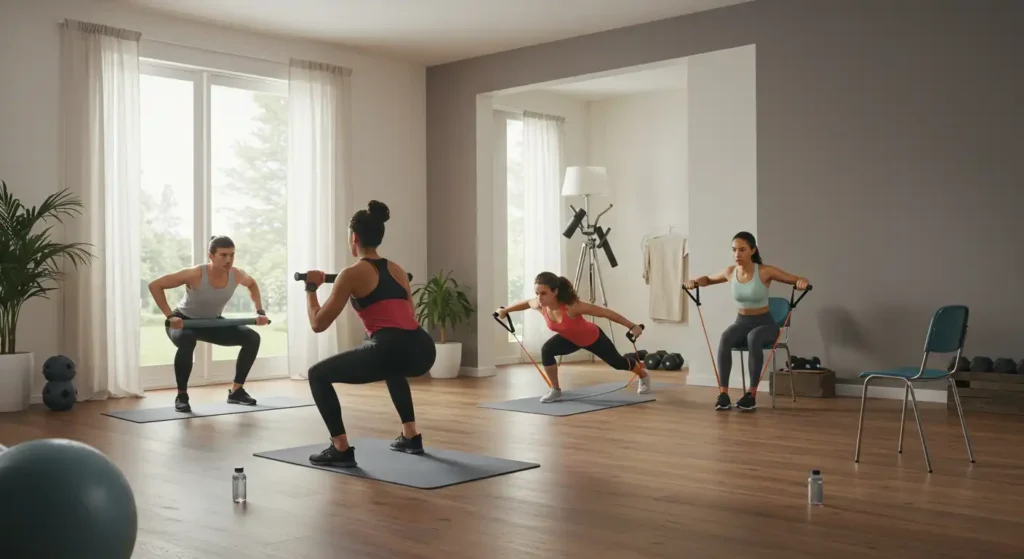
Making it Work for YOU: Modifications and Alternatives
Life isn’t always predictable, and neither is your body. Here’s how to adapt your approach to workout timing:
- ➲ Listen to Your Body (Seriously):
- Low Energy Morning? Don’t force a killer HIIT session. Opt for lighter cardio, mobility work, or yoga. Even a brisk walk counts!
- Dragging in the Evening? A shorter, focused workout is better than nothing. Maybe prioritize your main lift and skip accessory exercises. Or try a less intense activity like swimming or cycling.
- Feeling Amazing? Capitalize on it! Push a little harder, add an extra set, or try that challenging exercise you’ve been eyeing (safely, of course).
- ➲ Energy-Based Adjustments:
- Morning: If consistently sluggish, ensure adequate sleep, consider a small pre-workout snack, and allow for a longer warm-up.
- Evening: If consistently exhausted, evaluate your daily nutrition, stress levels, and sleep. Maybe a very short power nap (20 mins) post-work could help (if possible and doesn’t affect night sleep).
- ➲ When Neither Morning nor Evening Works:
- Lunchtime Power Hour: Can you squeeze in a 30-45 minute session during your lunch break? Many gyms cater to this crowd, or bodyweight circuits are effective.
- Workout Snacking: Break up activity throughout the day: 10-minute walk here, some bodyweight squats there, stairs instead of the elevator. It all adds up! Learn about NEAT – Non-Exercise Activity Thermogenesis
- Weekend Warrior (with caution): If weekdays are impossible, longer weekend sessions can help, but try to stay active during the week too (walks, stretching) to avoid injury risk from sudden intense bursts.
- ➲ Adapting for Injury or Lack of Equipment:
- Injury: Always consult a doctor or physical therapist. Modify exercises to avoid pain (e.g., incline push-ups instead of floor push-ups for wrist pain). Focus on what you can do.
- No Equipment: Bodyweight is king! Master variations of squats, lunges, push-ups, planks, glute bridges, burpees. Add plyometrics (jumping) for intensity once you have a solid base. Resistance bands are a low-cost, high-impact addition.
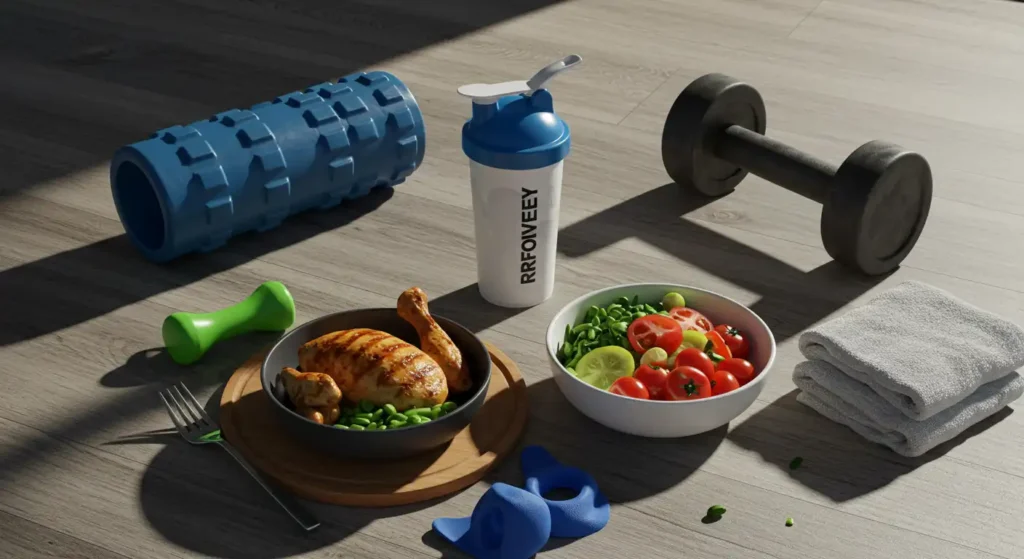
Post-Workout Power-Up: Fueling and Recovery (Time-Specific Tips)
What you do after your workout is just as crucial as the session itself, especially when considering timing.
- ➲ Hydration: Replenish fluids lost through sweat immediately. Water is usually sufficient, but consider electrolytes for longer/sweatier sessions.
- Morning: Continue hydrating throughout the day.
- Evening: Keep sipping water, but maybe slow down an hour or two before bed to avoid nighttime bathroom trips.
- ➲ Nutrition – The Anabolic Window Myth vs. Reality:
- The idea of a strict 30-60 minute “anabolic window” post-workout to slam protein is largely overstated for most people. Nutrient timing is important, but the window is more flexible, likely several hours around your workout.
- General Rule: Aim to consume a meal or snack containing both protein (for muscle repair) and carbohydrates (to replenish glycogen stores) within 1-2 hours of finishing your workout.
- Morning Post-Workout: This often naturally leads into breakfast. Focus on a balanced meal: eggs with whole-wheat toast and avocado, Greek yogurt with berries and nuts, oatmeal with protein powder and fruit.
- Evening Post-Workout: Be mindful of proximity to bedtime. A large, heavy meal might disrupt sleep. Opt for easily digestible options: protein shake, grilled chicken or fish with roasted vegetables, cottage cheese with fruit. Ensure sufficient protein for overnight muscle recovery. Avoid excessive sugary carbs right before bed.
- ➲ Recovery & Sleep:
- Stretching & Mobility: Spend 5-10 minutes post-workout doing static stretches (holding stretches for 15-30 seconds) or foam rolling. This can aid flexibility and potentially reduce muscle soreness.
- Active Recovery: On rest days, light activity like walking or gentle yoga can promote blood flow and reduce stiffness.
- SLEEP IS KING: This is non-negotiable for both fat loss and muscle gain. During sleep, your body repairs muscle tissue, consolidates memory, and regulates crucial hormones (like growth hormone and ghrelin/leptin, which control hunger). Aim for 7-9 hours of quality sleep per night.
- Evening Workout Consideration: If evening workouts energize you too much, ensure a solid wind-down routine: dim lights, avoid screens, maybe take a warm bath/shower, read a book. Protect your sleep!

Avoiding Pitfalls: Common Mistakes in Timing Your Workouts
Based on my experience as a trainer, here are some common errors people make when choosing between morning vs evening workouts:
➲ Ignoring Your Chronotype: The #1 mistake! The ‘fitness guru’ wakes up at 4 AM, but if you’re a natural night owl, forcing this will likely lead to misery, poor workouts, and quitting. Choose the time that genuinely aligns better with your body’s natural rhythm, even if it’s not “perfect.”
➲ Prevention: Experiment honestly for 1-2 weeks with each time slot. Track energy, mood, performance, and sleep. Be realistic about what feels sustainable.
➲ Sacrificing Sleep for Early Morning Workouts: Waking up an hour earlier is fine if you also go to bed an hour earlier. Cutting sleep consistently to fit in a workout is counterproductive. Sleep deprivation hinders recovery, messes with hunger hormones (making fat loss harder), reduces performance, and increases injury risk.
➲ Prevention: Prioritize 7-9 hours of sleep. If an early workout means consistently less than 7 hours, it’s not the optimal choice for you. Re-evaluate your schedule or consider other time slots.
➲ Skipping Warm-ups (Especially Mornings): Rushing into a morning workout without properly warming up is asking for injury. Your body temperature is lower, and tissues are less pliable.
➲ Prevention: Always allocate 5-10 minutes for dynamic stretching and light cardio, especially before morning sessions. Think of it as non-negotiable prep time.
➲ Poor Evening Pre/Post-Workout Nutrition & Timing: Eating a huge meal right before an evening workout leads to sluggishness and discomfort. Eating a massive meal or sugary snacks right after an evening workout close to bed can spike blood sugar and interfere with sleep quality and fat burning. Relying too heavily on pre-workout caffeine late in the day can also wreck sleep.
➲ Prevention: Time your evening meals/snacks appropriately (main meal 2-3 hours before, smaller snack 1 hour before if needed). Opt for balanced, easily digestible post-workout nutrition. Limit caffeine after mid-afternoon. Create a calming pre-sleep routine.
➲ Inconsistency – The Schedule Killer: Letting daily stressors derail evening workouts consistently, or hitting snooze repeatedly for morning sessions. Finding the “perfect” time means nothing if you don’t show up.
➲ Prevention: Treat your workouts like important appointments. Schedule them in your calendar. Prepare gear in advance. Have backup plans (shorter home workout if you can’t make the gym). Focus on building the habit first, then optimizing the details.
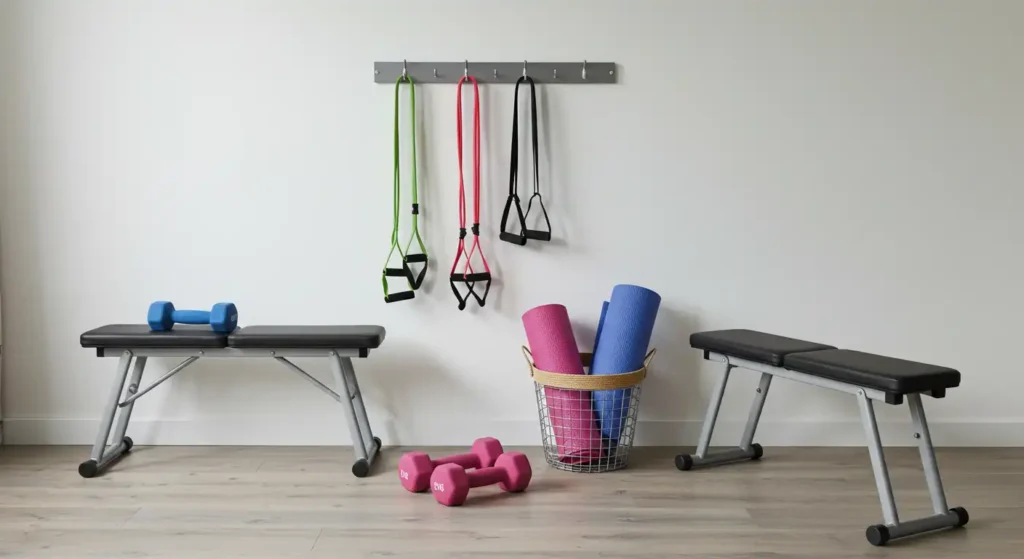
Making Space: Quick Gear Storage Tips
- Morning Quick Start: Keep your workout clothes, shoes, water bottle, and any small gear (headphones, fitness tracker) together in one spot, ready to grab and go.
- Evening Transition: If going straight from work, pack your gym bag the night before or morning of. Keep it visible (e.g., by the door) as a reminder.
- Home Gym Zone: Use designated bins or shelves for weights, bands, mats. Keep the area tidy and safe. Vertical storage (wall racks for weights/mats) can save space.
- Maintenance: Wipe down equipment after use. Check resistance bands for wear and tear. Ensure adjustable dumbbell mechanisms are secure.
The Final Verdict: So, Morning vs Evening Workouts – What’s TRULY Best?
We’ve journeyed through the science, the practicalities, and the potential pitfalls of the morning vs evening workouts debate. So, what’s the definitive answer?
The best time to work out is the time that allows you to be the most consistent, feel your best, and perform well enough to reach your specific goals.
- For fat loss, consistency is paramount. Mornings might offer a slight edge for habit formation and potentially tapping into fat stores for some, but a high-intensity evening workout can also yield excellent results. The key driver remains overall calorie balance and consistent activity.
- For muscle gain, evenings often align with peak physical performance, potentially allowing for heavier lifts and a greater growth stimulus. However, significant muscle can absolutely be built with dedicated morning training. Progressive overload and sufficient protein intake are crucial regardless of timing.
Ultimately, the “optimal” time is highly individual. It depends on your:
- Chronotype: Are you an early bird or a night owl?
- Schedule: Work, family, social commitments.
- Goals: Fat loss, muscle gain, performance, stress relief.
- Personal Preference: When do you enjoy moving your body the most?
Don’t get paralyzed by analysis paralysis. Experiment, listen to your body, and choose the time slot that makes fitness a sustainable part of your life. A “good enough” workout done consistently will always beat the “perfect” workout you rarely do.
Your Questions Answered: FAQs on Workout Timing
-
Is one time better for beginners?
For absolute beginners, the focus should be purely on building the habit of exercise. Often, mornings work well because willpower tends to be higher, and fewer things have cropped up to derail plans. However, if mornings feel absolutely dreadful, starting with evenings is perfectly fine. The key is consistency, not perfection from day one. Choose the path of least resistance initially.
-
What if I can only work out 2-3 times a week? Does timing matter more then?
With fewer sessions, making each one count is important. If your goal is muscle gain, trying to align those 2-3 sessions with when you feel strongest (often afternoons/evenings) might be slightly beneficial for maximizing lifting potential. For general fat loss or health, the consistency of those 2-3 sessions matters far more than the exact time. Just get them done!
-
How quickly will I see results depending on when I train?
Results depend on consistency, diet, genetics, sleep, stress levels, and the workout program itself – timing is a smaller variable. You’ll likely feel better (more energy, better mood, improved sleep) within a couple of weeks regardless of timing. Visible changes (fat loss, muscle definition) typically take longer, often 4-8 weeks of consistent effort, with significant changes occurring over months, not days. Timing alone won’t drastically speed this up; consistency and program effectiveness will.
-
Can I mix morning and evening workouts during the week?
Absolutely! This can be a great strategy to fit workouts around a variable schedule. For example, you might do strength training on weekday evenings when you have more time and feel stronger, and cardio or mobility work on weekend mornings. The key is maintaining overall weekly consistency and ensuring adequate recovery. Listen to your body’s feedback.
-
Does workout timing affect appetite or food choices differently?
It can. Some find morning workouts regulate their appetite throughout the day and encourage healthier choices. Others might feel ravenous after a morning session. Evening workouts might curb late-night snacking for some, while others might feel hungry close to bed. Pay attention to your own hunger cues and plan balanced meals and snacks accordingly around your chosen workout time to support your goals and energy levels.
Ready to Find Your Perfect Workout Time?
Now you have the insider knowledge on the morning vs evening workouts showdown. Remember, the most potent factor is YOU. Your commitment, your consistency, your willingness to listen to your body.
What’s YOUR experience? Are you Team Morning or Team Evening? Share your preference and any tips you have in the comments below!
And if you found this guide helpful, please share it with a friend who might be debating the best time to hit the gym.
Ready to take the next step? Experiment this week! Try one morning session and one evening session. See how you feel. Then, commit to the path that makes fitness feel less like a chore and more like a powerful part of your day. Let’s get moving!
- Need workout ideas? Check out our Workouts or Fitness Tips.
- Confused about nutrition? Read our Healthy Recipes or Meal Plans
- Struggling with motivation? Try these General Content.


